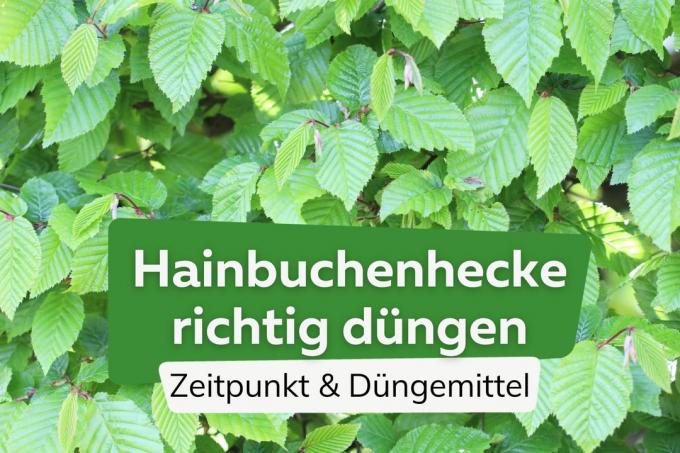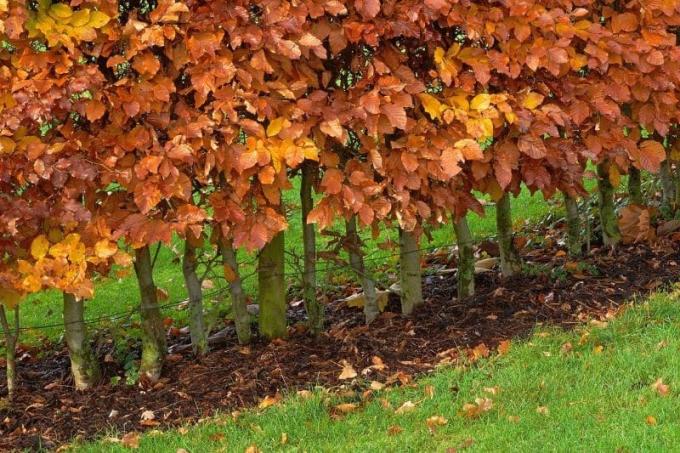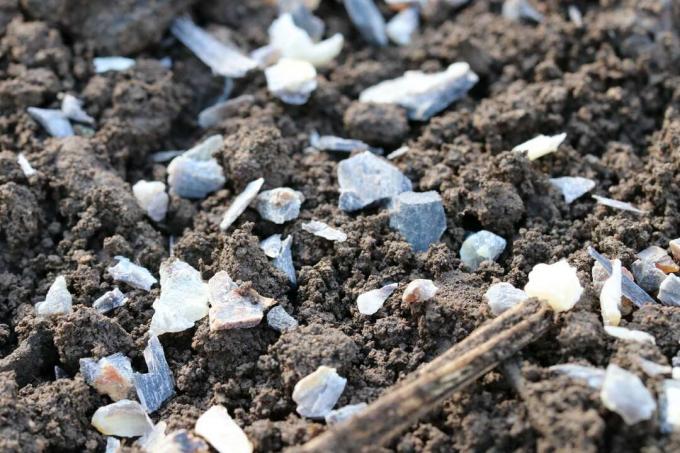
The hornbeam is undemanding, robust and very tolerant of pruning - so it's no wonder that the birch plant is often used for hedges. We show you how to properly fertilize the popular hornbeam hedge for healthy growth.
In a nutshell
- plant in well drained, humus rich and loamy soil
- Fertilization only necessary when planting and in the first few years
- mature (leaf) compost and horn meal are most suitable
- Fertilization only once a year for spring growth
- only fertilize older hornbeams with their own rotting leaves
Table of contents
- Nutrient requirements of the hornbeam hedge
- Suitable fertilizers
- time and frequency of fertilization
- Do not fertilize older hornbeams
- frequently asked Questions
Nutrient requirements of the hornbeam hedge
Also known as hornbeam because of its very light wood hornbeam (Carpinus betulus) is a native species that is perfectly adapted to the conditions in alluvial and deciduous forests deciduous tree, which is particularly popular as a hedge. The birch plant is very adaptable and undemanding, feels good in almost any location - whether sunny, semi-shady or even shady. The floor is optimal
- loose and well drained
- profound
- rich in humus
- clayey
- moderately moist to moist
Due to its high adaptability, however, the hornbeam quickly feels at home on sandy soils and similar subsoils - only the wood does not cope with waterlogging.

Like many native deciduous trees, the hornbeam only has a low nutrient requirement, which is reflected in the natural nutrient cycle from the decaying fall leaves and other organic matter covers. After all, nobody comes by in the forest to fertilize the trees regularly!
A notice: Incidentally, all these properties make the hornbeam a so-called “climate tree”, i. H. the species adapts well to changing climatic conditions and sometimes even copes with drought.
Suitable fertilizers
If the hornbeam is in a suitable, humus-rich location, it requires little additional fertilization. It is best to use well-ripened compost to fertilize the hornbeam hedge. Leaf compost in particular provides the hedge plants with all the nutrients they need. When planting the young trees, you can also add some horn meal or horn shavings. Later, however, you should refrain from fertilizing with nitrogenous fertilizers, as this promotes infestation with pests and fungal diseases. Instead of compost, a commercially available organic tree or hedge fertilizer with a low nitrogen content is also suitable.

Tip: More distributed under the hedge bark mulch not only keeps annoying weeds away and the moisture in the soil, but also provides the trees with valuable nutrients during the rotting process. Since hornbeams also tolerate slightly acidic pH values, the material does not harm them.
time and frequency of fertilization
You only have to fertilize a healthy hornbeam hedge with compost or a biological universal fertilizer at these times:
- when planting
- in the first, young years
- in case of deficiency symptoms
- on nutrient-poor soils
1. When planting
When planting, put a scoop of mature compost and some in each planting hole horn meal or horn shavings or an organic universal fertilizer with a long-term effect. Mix these fertilizers with the excavation and ensure that the saplings are kept slightly moist at all times for the next few weeks and months.
2. In the first few years

In order for the young hornbeam hedge to grow healthily and, above all, vigorously (after all, it should be as dense as possible are), in the first few years, annual fertilization with compost and, if necessary, horn meal sensible. Proceed as follows:
- optimal time for sprouting in spring
- per tree a shovel of compost plus approx. a tablespoonful of horn meal
- spread evenly around the trunk
- work into the soil as lightly as possible
- pour
A little later you cover the areas under the hedge high-quality bark mulch.
3. Fertilization in case of deficiency symptoms
Occasionally, hornbeam hedges develop deficiency symptoms, which are primarily indicated by deformed and/or discolored leaves. These deficiency diseases occur mainly in locations with nutrient-poor soils, e.g. B. sandy soils, before. Iron deficiency in particular occurs more frequently in such cases, which can be recognized by light, yellowish leaves with clearly protruding leaf veins. A special iron fertilizer, which is administered according to the instructions on the package, helps here.
4. Fertilization on nutrient-poor soils
In order to prevent such deficiency symptoms, hornbeam hedges are nutrient- and Fertilize humus-poor soils regularly. If the hedge is on sandy soil, a biologically based universal long-term fertilizer is the best choice. Be sure to apply the last dose of fertilizer in June at the latest so that the young, soft shoots can mature in time before winter.
Do not fertilize older hornbeams

Older, well-established hornbeam hedges usually no longer need to be fertilized. It is sufficient if you spread the autumn leaves under the hedge and let them rot there - just like in nature.
frequently asked Questions
All mineral fertilizers such as, for example, are unsuitable for hornbeam hedges blue grain. These contain far too much nitrogen and also damage soil life, i. H. prevent the development of a healthy one humus soil. Also strong nitrogenous organic fertilizers such as horse manure or cattle dung are not recommended for hornbeams.
Hornbeams are mainly found in damp alluvial forests and therefore feel more comfortable in a hedge in the home garden on slightly damp soil. Water the hornbeam hedge, especially on dry, hot days, according to the following rule of thumb: Give approx. 10 liters of water. The best time to water is in the early morning or late evening hours.
Sometimes the recommendation can be read to fertilize hornbeam hedges after cutting. However, it is better not to do this, especially after a summer cut, as the shoots that sprout more intensively afterwards can no longer mature and freeze back in cold winters. Instead, be sure to water the shrubs thoroughly after pruning and keep the soil slightly moist at all times for the weeks that follow.
